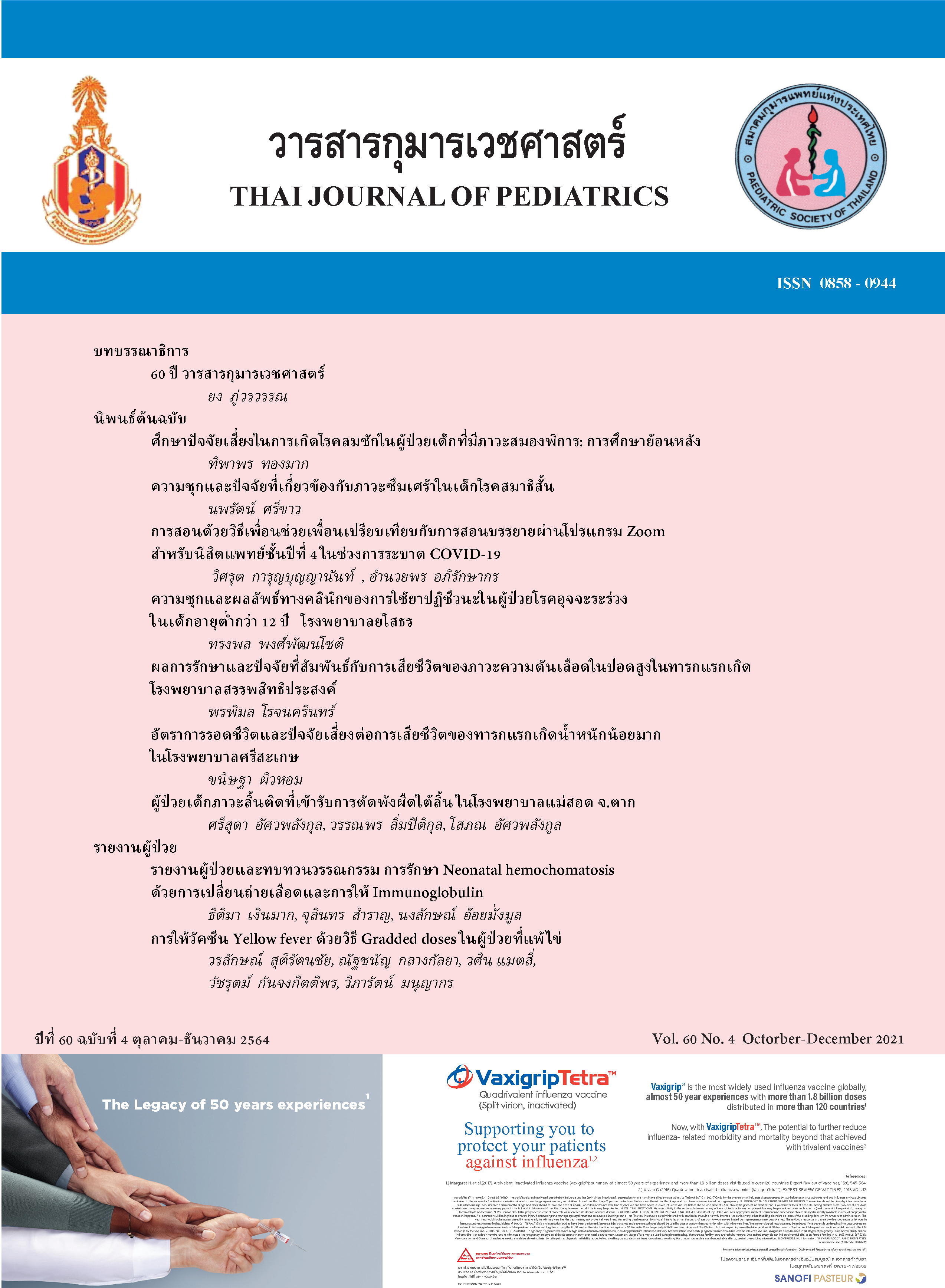การสอนด้วยวิธีเพื่อนช่วยเพื่อนเปรียบเทียบกับ การสอนบรรยาย ผ่านโปรแกรม Zoom สำหรับนิสิตแพทย์ชั้นปีที่ 4 ในช่วงการระบาด COVID-19
คำสำคัญ:
COVID-19, การสอนแบบวิธีเพื่อนช่วยเพื่อน, การสอนแบบบรรยายผ่านโปรแกรม ZOOM, การติดเชื้อระบบหายใจในเด็กบทคัดย่อ
ความเป็นมา: การเรียนการสอนนิสิตแพทย์ตามปกติในช่วงการระบาค CO VID-19 ได้รับผลกระทบและจำเป็นต้องปรับรูปแบบการเรียนการสอนเป็นแบบออนไลน์เพื่อรักษาระยะห่างทางสังคม ในขณะก็ยังคงรักษาผลลัพธ์การเรียนการสอนให้เหมือมเดิม
วัตถุประสงค์: เพื่อศึกษาเปรียบเที่ยบผลลัพธ์การเรียนและความพึ่งพอใจต่อการเรียนการสเพื่อนช่วยเพื่อน (PAL) กับการสอนบรรยายผ่านโปรแกรม ZOOM (LZ1) ในเรื่องการดิดเชื้อระบบหายใจในเด็ก (ARIs) สำหรับนิสิตแพทย์
วิธีการศึกษา: การศึกษาแบบตัดขวางในนิสิตแพทย์ชั้นปีที่ 4 รายวิชากุมารเวชศาชตร์ โรงพยาบาลภูมิพลอดุลยเดช ปีการศึกษ1 2562 เรื่องการติดเชื้อระบบหายใจในเด็ก นิสิตแพทย์ถูกแบ่งแบบสุ่มเป็น 2 กลุ่ม PAL แถะ LZL กลุ่มถะ 14 คน ในกชุ่ม PAL มิสิดแพทย์อภิปรายกับอาจารย์และเตรียม PowerPoint
สอนเพื่อนภายใต้การควบคุมอาจารย์ในกลุ่ม LZL นิสิตแพทย์อ่านเอกสารประกอบการบรรยายก่อนเข้าเรียน บรรยายโดยอาจารย์ผ่านโปรแกรม
ZOOM คะแนนสอบก่อนและหลังการเรียนด้วยคำถามหลายตัวเลือก แบบสอบถามความพึงพอใจและข้อเสนอแนะรวบรวมและวิเคราะห์
ผลการศึกษา: นิสิตแพทย์จำนวน 28 คนได้แบ่งกลุ่ม 2 กลุ่ม PAL และ [ZL มีเกรดเฉลี่ยสะสมใกล้เคียงกันคือ 3.23 และ 3.20 ตามลำคับ ค่าเฉลี่ยคะแนนสอบก่อนและหลังเรียนของกลุ่ม PAL แถะ LZL เท่ากับ 53.0 21.1 / 73.8
14.2 (ผลต่างค่าเฉลี่ย 39.3; 95% CI, 8.4 to 33.3; P 0.003) และ 65.5
18.7/79.8
18.7(ผลต่างค่าเฉลี่ย 39.3 95% CI, 5.0 t0 23.6: P 0.006) ตามลำดับ ค่ามัธยฐานคะแนนความพึ่งพอใจของนิสิตแพทย์ในกลุ่ม PAL และ LZL เท่ากับ 34 (IQR 2-4) and 3.5 (IOR 3-4) และไม่มีความแตกต่างอย่างมีนัยสำคัญ
สรุป: การเรียนการสอน ARUI ด้ววิธี PAL และ LZL สามารถเพิ่มคะแนนสอบหลังเรียนอย่างมีนัยสำคัญและนิสิตแพทย์มีความพึงพอใจในการเรียนทั้ง 2 วิธีไม่แตกต่างกัน วิธีการสอนนี้สามารถนำไปปรับใช้ในการเรียนการสอนในบริบทอื่น รวมถึงทักษะทางคลินิกที่ท้าทายต่อไป
Downloads
เอกสารอ้างอิง
แพทยสภา. เกณฑ์ความรู้ความสามารถในการประเมิน เพื่อรับใบอนุญาตเป็นผู้ประกอบวิชาชีพเวชกรรม พ.ศ.2555 [อินเทอร์เน็ต]. นนทบุรี:สำนักงานเลขาธิการแพทยสภา; 2551 [เข้าถึงเมื่อ 18 ธ.ค. 2563]. เข้าถึงได้จาก : https://www.tmc.or.th/file_08062012.pdf
Callas PW, Bertsch TF, Caputo MP, Flynn BS, Doheny-Farina S, Ricci MA. Medical student evaluations of lectures attended in person or from rural sites via interactive videoconferencing. Teaching and Learning in Medicine. 2004;16:46-50.
Bertsch TF, Callas PW, Rubin A, Caputo MP, Ricci MA. Applied research: Effectiveness of lectures attended via interactive video conferencing versus in-person in preparing third-year internal medicine clerkship students for clinical practice examinations (cpx). Teaching and learning in medicine. 2007 ;19:4-8.
Engilman WD, Cox TH, Bednar ED, Proffit WR. Equipping orthodontic residency programs for interactive distance learning. American Journal of Orthodontics and Dentofacial Orthopedics. 2007;131:651-5.
Schreiber BE, Fukuta J, Gordon F. Live lecture versus video podcast in undergraduate medical education: A randomised controlled trial. BMC medical education. 2010 ;10:1-6.
Daud S, Chaudhry AM, Ali SK. Lecture based versus peer assisted learning: Quasiexperimental study to compare knowledge gain of fourth year medical students in community health and nutrition course. Research and Development in Medical Education. 2016 ;5:62-8.
Nourkami-Tutdibi N, Hofer M, Zemlin M, Abdul-Khaliq H, Tutdibi E. TEACHING MUST GO ON: flexibility and advantages of peer assisted learning during the COVID-19 pandemic for undergraduate medical ultrasound education–perspective from the “sonoBYstudents” ultrasound group. GMS Journal for Medical Education. 2021;38.
Topping KJ. The effectiveness of peer tutoring in further and higher education: A typology and review of the literature. Higher education. 1996;32:321-45.
Henning JM, Weidner TG, Jones J. Peerassisted learning in the athletic training clinical setting. Journal of Athletic Training. 2006;41:102.
Siddiqui S, Siddiqui S, Mustafa Q, Rizvi AF, Hossain IT. The benefits of a peerassisted mock PACES. The clinical teacher. 2018;15:221-5.
Nielsen E, Sheppard MA. Television as a patient education tool: a review of its effectiveness. Patient Education and Counseling. 1988;11:3-16.
ดาวน์โหลด
เผยแพร่แล้ว
รูปแบบการอ้างอิง
ฉบับ
ประเภทบทความ
สัญญาอนุญาต

อนุญาตภายใต้เงื่อนไข Creative Commons Attribution-NonCommercial-NoDerivatives 4.0 International License.



